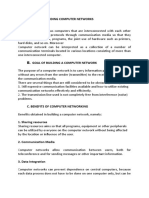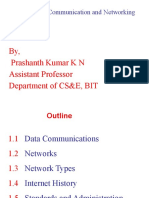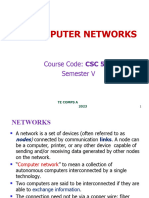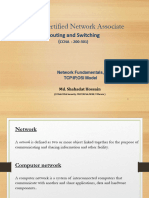Introduction To Data Communication
Uploaded by
ScribdTranslationsIntroduction To Data Communication
Uploaded by
ScribdTranslationsPlanning and management of networks Introduction to data communication
Introduction to data communication
1. Basic concepts.
In 1982, personal computers emerged, becoming a common work tool today.
The diffusion of the computer has imposed the need to share information, programs, resources, access
to other computer systems within the company and connect to databases located physically
on other computers, etc. Currently, an adequate interconnection between users and processes of
a company or organization can constitute a clear competitive advantage. The reduction of costs
peripherals, or the ease of sharing and transmitting information are the key points on which it relies
increasing use of data transmission networks.
A data transmission network is a set of interconnected computers that can
communicate by sharing data and resources regardless of the physical location of the different
devices. Through a network, processes can be executed on another computer or access its files,
send messages, share programs, etc.
Computers are often connected to each other by cables. But if the network covers an extensive area,
connections can be made through telephone lines, microwaves, fiber optic lines and
even satellites.
Each active device connected to the network is called a node. An active device (node) is one that
that intervenes in communication autonomously, without being controlled by another device. For
For example, certain printers are standalone and can provide service on a network without connecting to a
computer that manages them; these printers are nodes of the network.
IES Mar de Cádiz Course 2010/2011 Page 1 of 8
Network planning and management Introduction to data communication
If we want to allow communication between several computers, we need to connect them to a network.
data transmission. This network is made up of three fundamental parts:
a) Nodes or terminals: they are the devices that communicate, such as computers, phones, printers.
of the network, etc. These determine the nature of the information that the network will have to handle.
(voice, data, etc.).
b) Network devices: corresponds to the set of physical elements that make it possible
communication between the sending node and the receiving node. These devices are:
i.Communication channel: it is the means by which information circulates.
ii. Interconnection elements: they are responsible for interconnecting all the terminals of
the network and they also work to select the best path for circulation
information (in case there is more than one way, which will be normal).
iii.Network adapters: they are responsible for converting the information format of the
nodes (usually in the form of electrical signals) in the format used by the network
communication (electrical signals, radio waves, light pulses, etc.).
c) Network programs: they are all the programs that allow controlling the operation of the network,
to make it more reliable, user-friendly, etc.
2. Services and protocols.
The networks are oriented towards the transmission of information between certain geographic areas. This
such a general idea turns into practice with many kilometers of wiring connected to control centers and
other devices, all of which aimed at providing a set of services to the user.
The communication services provided by a data transmission network follow a
well-established and standardized protocols. If a particular network wishes to add a
specific functionality, it will be necessary to check if it has the appropriate protocol or if it needs to be added.
A network protocol defines rules to follow when transmitting information, rules that can
ser: transmission speed, type of information, message format, etc.
3. Classification of networks.
Networks are classified into different types based on various criteria. Below we
They relate several classifications according to the most important criteria.
3.1. According to the ownership of the network.
This classification addresses the property of the network, so it can be divided into two types of
networks:
Dedicated networks: these are the ones where the communication lines are installed by the user.
or rented from communication companies for the exclusive use of the client. An example
This type of network is the local network of an institute.
Shared networks: these are the ones where the communication lines carry information from
different users. It involves in all cases public service networks offered by the
telecommunications companies under rental fees based on connection time,
IES Mar de Cádiz Course 2010/2011 Page 2 of 8
Network planning and management Introduction to data communication
transmission speed, amount of information, etc. An example of this type is the network of
landline, the mobile phone network, etc.
3.2. According to its topology.
In the topology of a network, it is commonly understood as the shape of the network, that is, the way in which it...
carry out the connection of all its nodes.
The most common topologies are the following:
Mesh: A network has a mesh topology or is a mesh network when each node is
connected to one or more of the other nodes. In this way, it is possible to carry the messages from a
node to another by different paths.
This type of networks has the advantage that, if one route fails, another alternative can be selected.
but with the drawback that they are networks with high construction costs.
Bus: Bus topology is a simple design in which a single cable, known as
"bus" is shared by all devices on the network. The cable runs through each of the
computers and a termination is used at each of the two ends. The nodes are connected
the bus generally using a T connector.
The bus topology allows all network nodes to see all the signals of the others,
What can be advantageous if you want all nodes to obtain this information. However,
it can represent a disadvantage, as it is common for collision problems to occur, which
They can be alleviated by segmenting the network into several parts.
The advantages of bus networks are their simplicity and cost-effectiveness. One drawback, apart from the
collisions, it's just that if the cable fails at any point, the entire network stops working.
IES Mar de Cádiz Course 2010/2011 Page 3 of 8
Network planning and management Introduction to data communication
Ring: Network topology in which stations are connected forming a ring. Each station
is connected to the following one and the last one is connected to the first. Each station has a
receiver and a transmitter that acts as a repeater, passing the signal to the next station
of the ring. The ring is unidirectional, in such a way that the information packets that
Data is transported circulating around the ring in one direction.
In this type of network, communication occurs through the passage of a token, which is passed along from
a computer to the next one in the ring, the computer that has the token is the only one that will be able to
transmit, and if there is nothing to send, pass the baton to the next node, this way it is avoided
loss of information due to collisions.
It is worth mentioning that if any node in the network goes down (an IT term meaning it is malfunctioning)
functioning or not functioning at all) communication throughout the ring is lost.
Star: The nodes of the network connect with cables dedicated to a central node which is a box.
of connections (hub, switch or router). In a star topology, each workstation has its
dedicated cable itself, so longer lengths of cable are usually used.
The detection of wiring issues in this system is very simple as each station has
he works on his own cable. For the same reason, the failure resistance is very high since a problem
in a cable will only affect the node that connects to the network through it.
IES Mar de Cádiz Course 2010/2011 Page 4 of 8
Network planning and management Introduction to Data Communication
Tree: Tree topology is similar to a series of interconnected star networks.
3.3. According to the way of transferring information from the source to the destination.
Switched networks: In this type of network, the sending node transmits information to the receiving node and it is
the network is responsible for enabling a connection path between the two nodes. There are three ways to
do this:
Circuit switching: in this type of communication a unique path is established
dedicated. The route that the information follows is established throughout the entire process of
communication. Once the communication is finished, the connection route is released. This
the method used in telephone calls.
Message switching: the complete information of the message along with the address of
The destination is sent by the sender to the next node in the network according to a routing criterion to reach the
destination. When all the information reaches the first node, it uses another criterion of
route sends the entire message to the next node and so on until it reaches the node
recipient.
Packet switching: in this case, the message to be sent is divided into fragments or
packets, each of which is sent to the network and circulates through it until it reaches its
destination. Not all packages have to go the same way, when a package arrives
to a node, it forwards it to the next node according to a routing criterion, and it is at the node
destination where the packages will be assembled in order to display the message.
Broadcast networks: in this case, a device or node sends information to all nodes.
that is connected and is the recipient responsible for selecting and capturing that information. This
The way of transmitting information is conditioned by the topology of the network, as it is
is characterized by having a single communication pathway that must be shared by all
the nodes. This means that it must have a bus or ring topology, or it must be based on
radio wave links. Although at first glance this type of network may seem somewhat
IES Mar de Cádiz Course 2010/2011 Page 5 of 8
Planning and management of networks Introduction to data communication
efficient, in practice it is widely used in small networks, as they do not require the use of
of complicated switching devices to select routes since there is only one, which is
shared by all.
3.4. According to its geographical location.
Local Area Networks (LAN): a LAN is a network whose range does not exceed the same building
where it is installed.
Red campus: a campus network extends between several buildings within the same polygon.
industrial, which are generally connected to a main cable network.
Metropolitan Area Network (MAN): a MAN is confined within the same city and
is subject to local regulations. It may consist of various public or private resources, such as
the local telephone system, local microwave systems, or buried fiber optic cables.
A local company builds and maintains the network and makes it available to the public. They can be
used by companies to connect their LANs that are distributed across different locations
from the same city.
IES Mar de Cádiz Course 2010/2011 Page 6 of 8
Network planning and management Introduction to data communication
Wide Area Network (WAN): these networks cover several cities, regions, or countries. The links
WANs are generally offered by public or private telecommunications companies. Their
The fundamental function is aimed at the interconnection of networks or terminal equipment that
are located at great distances from each other.
4. Standardization and organizations.
The first computer networks that were built, both commercial and military,
they used their own protocols. This situation led companies to maintain networks of different
manufacturers. When they needed to communicate those networks, problems arose: the systems of
the transmissions were not compatible, and either it was necessary to get rid of everything installed and set up networks
new ones, or it was necessary to develop network adapter equipment, a very expensive alternative.
From then on it was verified that it was necessary to define a set of rules that allowed
coordinate all manufacturers. These standards enable communication between different devices and
they allow these to have a lower cost and greater adaptation. The rules are divided into two
categories
De facto standards: it comes from the word that means 'in fact' in Latin and this group includes the
standards that simply appeared and were imposed on the market due to their extensive use. The
The UNIX operating system has become a de facto standard as it has been copied by others.
manufacturers: SCO, Minix, Linux, etc.
De jure standards: comes from Latin meaning by law and refers to formal and legal standards.
agreed upon by some authorized standardization body.
There are several organizations dedicated to normalization and standardization tasks. Among them
we highlight:
ISO (International Standard Organization): it is a voluntary organization that
groups 89 countries. It has developed standards for the participating nations. One of its
committees deal with information systems, which has developed the reference model
OSI and protocols for various levels of this model. ISO has also developed other
standards in other fields, such as ISO 216 (for paper sizes, such as A4), ISO 9000
(quality management systems), ISO 3166 (country codes), etc.
IES Mar de Cádiz Course 2010/2011 Page 7 of 8
Planning and management of networks Introduction to data communication
ANSI (American National Standards Institute): A non-profit association formed by
manufacturers, users, companies that provide public communication services and others
organizations interested in communication issues. He is the American representative of ISO,
which often adopts ANSI standards as international standards.
IEEE (Institute of Electrical and Electronics Engineers): It is the largest international organization
non-profit organization formed by professionals in new technologies. Creates standards in the
areas of electrical and computer engineering, such as the IEEE 802 standard for local area networks or
the POSIX standard for operating systems.
IETF (Internet Engineering Task Force): It is an organization created in the United States to
develop the standards that work on the Internet. The documents they publish are called
RFCs are the foundation of all technologies that function on the Internet (RFC 2616 for HTTP, RFC
959 for FTP, RFC 854 for Telnet, etc.
W3C (World Wide Web Consortium): it is an organization whose goal is to produce standards for
all the technologies encompassed by the World Wide Web (WWW). Their standards are published by
free form for manufacturers to adopt. Some of their recommendations are XHTML,
CSS, DOM, XML, etc., used for web page design.




















































































































